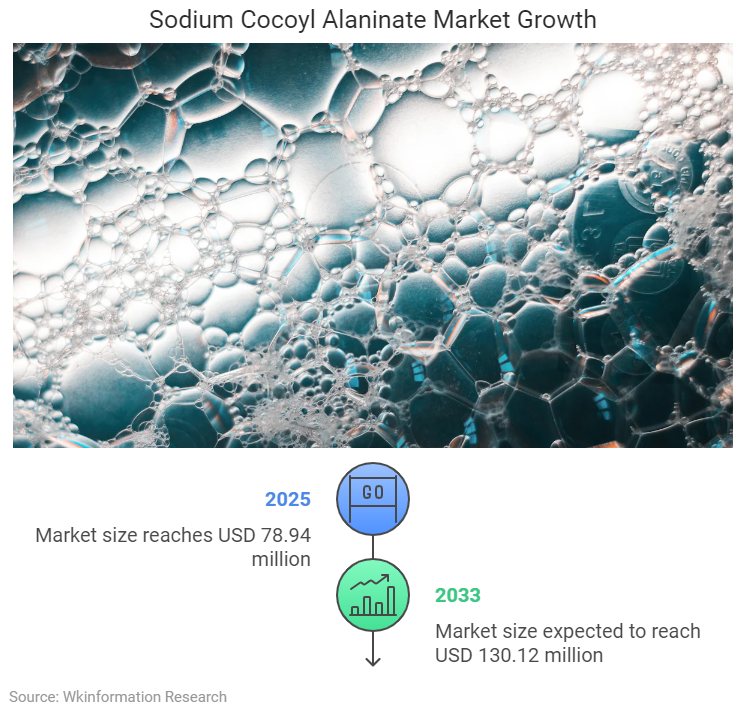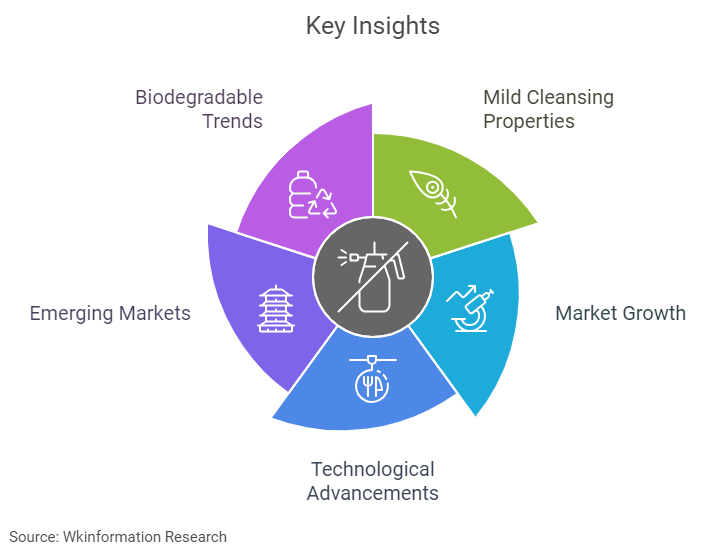
The Sodium Cocoyl Alaninate Market has witnessed remarkable growth, driven by the rising demand for natural surfactants in personal care products. This plant-derived ingredient aligns with the global shift toward sustainability, offering biodegradable properties and reducing skin irritation by preserving natural oils. Consumers increasingly prefer eco-friendly formulations, fueling market expansion. The market size will reach USD 78.94 million in 2025 and is expected to reach USD 130.12 million by 2033, with a CAGR of 6.45% from 2025 to 2033, reflecting its critical role in the cosmetics industry. Its ability to meet regulatory and environmental standards positions it as a cornerstone of sustainable innovation.
Key Insights
- Sodium Cocoyl Alaninate is a plant-based surfactant that offers mild cleansing properties, making it ideal for sensitive skin and sulfate-free formulations.
- The market for Sodium Cocoyl Alaninate is projected to grow significantly, reaching USD 130.12 million by 2033, driven by increasing consumer demand for sustainable and eco-friendly personal care products.
- Technological advancements in production processes are enhancing the efficiency and scalability of Sodium Cocoyl Alaninate, making it more accessible to manufacturers.
- Emerging markets, particularly in the Asia-Pacific region, present vast opportunities for growth due to rising disposable incomes and a shift towards natural ingredients.
- Manufacturers can capitalize on the growing trend for biodegradable and plant-derived surfactants by developing innovative, eco-friendly personal care products.

Sodium Cocoyl Alaninate Market Overview
Definition and Composition
Sodium Cocoyl Alaninate is a plant-based surfactant created by combining alanine, an amino acid, with fatty acids derived from coconut oil. This compound is widely recognized for its mild cleansing properties, making it a preferred ingredient in cosmetics and personal care products. It produces a rich, creamy lather while being gentle on the skin and hair, reducing irritation and preserving natural oils. As a biodegradable and eco-friendly ingredient, it aligns with the increasing demand for sustainable solutions in the Sodium Cocoyl Alaninate Market.
Role in the Industry
Eco-Friendly and Biodegradable Properties
The eco-friendly nature of Sodium Cocoyl Alaninate has made it a cornerstone in the development of sustainable personal care products. Its biodegradability ensures minimal environmental impact, addressing growing concerns about pollution caused by synthetic surfactants. Manufacturers leverage this property to meet stringent environmental regulations and cater to environmentally conscious consumers. This trend has significantly contributed to the expansion of the Sodium Cocoyl Alaninate Market.
Importance in Sulfate-Free Formulations
Sodium Cocoyl Alaninate plays a vital role in sulfate-free formulations, which have gained popularity due to their gentler impact on skin and hair. Unlike traditional sulfates, this surfactant cleanses effectively without stripping away natural oils, making it ideal for sensitive skin. Its inclusion in sulfate-free shampoos, facial cleansers, and body washes enhances product performance while meeting consumer preferences for milder alternatives. This shift toward sulfate-free products has further solidified its position in the global market.
Current Trends in the Sodium Cocoyl Alaninate Market

Rising Demand for Sustainable Ingredients
Consumer Preference for Natural Products
Consumers increasingly favor natural and eco-friendly products, driving the demand for sustainable ingredients like Sodium Cocoyl Alaninate. This trend stems from heightened environmental awareness and the growing popularity of clean beauty. Social media platforms have played a pivotal role in educating consumers about the benefits of plant-derived surfactants. As a result, manufacturers are prioritizing natural formulations to meet these evolving preferences.
Regulatory Push for Eco-Friendly Formulations
Regulatory bodies worldwide are implementing stricter standards to promote sustainability. These regulations encourage the use of biodegradable and renewable ingredients like Sodium Cocoyl Alaninate. However, compliance with these standards can pose challenges for new manufacturers. Despite this, the regulatory push aligns with the global shift toward sustainable practices, further boosting the Sodium Cocoyl Alaninate Market.
- Increased Demand for Sustainable Products: Climate change awareness has led to a surge in demand for plant-derived surfactants.
- Regulatory Standards: Strict ingredient and labeling regulations in various regions influence market dynamics.
Technological Advancements
Innovations in Production Processes
Technological advancements have revolutionized the production of Sodium Cocoyl Alaninate. Enhanced synthesis techniques now allow manufacturers to produce high-quality surfactants more efficiently. These innovations reduce production costs and improve the scalability of manufacturing processes, making the ingredient more accessible to a broader market.
Enhanced Product Performance
Recent developments in amino acid-based surfactants have significantly improved the performance of Sodium Cocoyl Alaninate. Manufacturers can now tailor its properties to specific applications, such as personal care and enhanced oil recovery. This customization ensures superior cleansing and foaming capabilities, solidifying its position as a preferred ingredient in the Sodium Cocoyl Alaninate Market.
- Fine-tuning properties enhances its effectiveness in various applications.
- Tailored surfactants outperform traditional petroleum-based alternatives.
Sodium Cocoyl Alaninate Market Share Analysis
By Region
Asia-Pacific as a Leading Market
The Asia-Pacific region dominates the Sodium Cocoyl Alaninate Market, emerging as the largest and fastest-growing market globally. Rapid urbanization and increasing disposable incomes have fueled the demand for personal care products in countries like China, India, and Japan. Manufacturers in this region benefit from a favorable regulatory environment and abundant raw materials, enabling them to scale production efficiently. The region’s focus on sustainability further drives the adoption of eco-friendly surfactants, solidifying its leadership position.
Market Share in North America and Europe
North America and Europe hold significant shares in the Sodium Cocoyl Alaninate Market. Consumers in these regions prioritize sustainable and biodegradable ingredients, aligning with the clean beauty movement. In North America, the United States leads the market due to its advanced personal care industry and high consumer awareness. Europe, known for its stringent environmental regulations, has also witnessed steady growth. However, high production costs and regulatory compliance challenges remain barriers for manufacturers in these regions.
By Type
Powder Form
The powder form of Sodium Cocoyl Alaninate is widely used in dry formulations such as facial cleansers and powdered detergents. Its lightweight nature and ease of transportation make it a cost-effective choice for manufacturers. Additionally, the powder form offers excellent stability and a longer shelf life, making it suitable for bulk storage and export.
Liquid Form
The liquid form is preferred for applications requiring easy solubility and quick processing. It is commonly used in liquid shampoos, body washes, and industrial cleaning agents. Its ability to blend seamlessly with other ingredients enhances its versatility, making it a popular choice among formulators. The liquid form also allows for precise dosing, ensuring consistent product quality.
By Application
Personal Care Products
Personal care products represent the largest application segment in the Sodium Cocoyl Alaninate Market. This surfactant’s mild cleansing properties and compatibility with sulfate-free formulations make it ideal for shampoos, facial cleansers, and body washes. Its ability to produce a rich lather while being gentle on the skin has made it a staple in premium and natural personal care brands.
Industrial and Household Cleaning
Sodium Cocoyl Alaninate is also gaining traction in industrial and household cleaning applications. Its biodegradable nature and effective cleansing properties make it a sustainable alternative to traditional surfactants. It is used in dishwashing liquids, laundry detergents, and surface cleaners, where environmental considerations are increasingly influencing consumer choices.
Key Players
- Ajinomoto
- Sino Lion
- Tinci
- Miwon
- Taiwan NJC
- Shanghai OLI Industrial
- Huzhou Ouli Biotechnology
Major Manufacturers and Suppliers
The Sodium Cocoyl Alaninate Market features several prominent manufacturers and suppliers who play a pivotal role in shaping the industry. These companies leverage their expertise and resources to meet the growing demand for sustainable surfactants.
These manufacturers have established themselves as leaders by consistently delivering high-quality products and maintaining a strong presence in the global market. Their contributions have been instrumental in driving innovation and sustainability within the Sodium Cocoyl Alaninate Market.
Competitive Landscape
Key players in the Sodium Cocoyl Alaninate sector employ various strategies to maintain their competitive edge. Innovation remains a cornerstone of their approach, with significant investments in research and development. This focus enables them to adapt to evolving market demands and introduce advanced formulations that cater to consumer preferences.
Strategic partnerships also play a crucial role in strengthening their market position. Collaborations with raw material suppliers and distributors ensure a steady supply chain and enhance market reach. These alliances allow manufacturers to expand their footprint in emerging economies, where demand for personal care products continues to rise.
Sustainability has emerged as a defining factor in the competitive landscape. Leading brands prioritize transparency and environmental responsibility, aligning their operations with global sustainability goals. Companies that adopt eco-friendly practices and emphasize biodegradable ingredients are better positioned to succeed in this market.
Advancements in production technologies further bolster the competitive strategies of top manufacturers. By optimizing manufacturing processes, they reduce costs and improve product performance. This approach not only enhances profitability but also ensures the availability of high-quality surfactants to meet diverse application needs.
The Sodium Cocoyl Alaninate Market continues to evolve, with key players driving progress through innovation, partnerships, and a commitment to sustainability. Their efforts underscore the importance of adaptability and forward-thinking in maintaining a strong market presence.
Growth Drivers and Challenges in the Sodium Cocoyl Alaninate Market

Growth Drivers
Increasing Demand for Sulfate-Free Surfactants
The global shift toward sulfate-free formulations has significantly boosted the demand for Sodium Cocoyl Alaninate. Consumers increasingly seek products that are gentle on the skin and hair, avoiding harsh chemicals like sulfates. Sodium Cocoyl Alaninate, with its mild cleansing properties, has become a preferred ingredient in shampoos, facial cleansers, and body washes. Its ability to maintain natural oils while delivering effective cleansing aligns with consumer preferences for sulfate-free alternatives. This trend has positioned it as a key player in the Sodium Cocoyl Alaninate Market.
Rising Awareness of Environmental Sustainability
The rising awareness of environmental sustainability has emerged as a major growth driver. Consumers now prefer natural and biodegradable ingredients, prompting manufacturers to prioritize eco-friendly formulations. The growing demand for organic and vegan personal care products further underscores this shift. Industries increasingly recognize the role of Sodium Cocoyl Alaninate in sustainable practices, driving its adoption across various applications.
The market’s steady growth reflects the increasing consumer awareness of natural ingredients and the industry’s commitment to sustainability.
Expanding Personal Care Industry
The personal care industry continues to expand, particularly in emerging economies. Rising disposable incomes and urbanization have fueled the demand for premium and natural personal care products. Sodium Cocoyl Alaninate’s compatibility with sulfate-free and eco-friendly formulations makes it a staple in this growing sector. Its versatility and performance ensure its widespread use in shampoos, cleansers, and other personal care items.
Challenges
High Production Costs
The high production costs of Sodium Cocoyl Alaninate present a significant challenge. Compared to traditional surfactants, its manufacturing involves more complex processes and higher raw material expenses. These factors increase the overall cost, making it less accessible to price-sensitive markets. Manufacturers must balance quality and affordability to remain competitive.
Limited Availability of Raw Materials
The limited availability of raw materials impacts both production and pricing. Coconut oil, a primary ingredient, faces supply chain disruptions due to environmental and geopolitical factors. These disruptions affect manufacturing efficiency and lead to fluctuating prices. Transportation and processing costs further compound the issue, creating challenges for manufacturers aiming to scale production.
Competition from Alternative Surfactants
The market faces competition from alternative surfactants that offer similar benefits at lower costs. Synthetic surfactants, though less eco-friendly, remain widely used due to their affordability and availability. Manufacturers of Sodium Cocoyl Alaninate must emphasize its unique properties, such as biodegradability and mildness, to differentiate it from competitors and maintain market share.
Future Projections for the Sodium Cocoyl Alaninate Market
Market Growth Forecast
Projected CAGR and Market Size by 2033
The Sodium Cocoyl Alaninate market is expected to experience robust growth over the coming years. Projections indicate a compound annual growth rate (CAGR) of 6.45% from 2025 to 2033, with the market size reaching USD 130.12 million by 2033. This growth reflects the increasing demand for sustainable and natural ingredients in personal care products, driven by consumer preferences and regulatory pressures.
Emerging Markets and Opportunities
Emerging markets present vast opportunities for the Sodium Cocoyl Alaninate market. Over 70% of consumers now favor products labeled as “natural,” creating a strong demand for plant-derived surfactants. The global natural and organic personal care market is projected to grow at a CAGR of 10-12% over the next five years, aligning with the trend toward sustainability. Modern consumers seek products that are both effective and gentle, further driving the adoption of Sodium Cocoyl Alaninate in formulations.
Innovations and Opportunities
Cost-Effective Production Methods
Manufacturers are exploring innovative production methods to address high costs associated with Sodium Cocoyl Alaninate. Advances in synthesis techniques aim to reduce raw material wastage and improve efficiency. These developments could make the ingredient more accessible to price-sensitive markets while maintaining its eco-friendly properties.
Expansion into New Applications
The versatility of Sodium Cocoyl Alaninate opens doors to new applications beyond personal care. Its mildness and biodegradability make it suitable for industrial and household cleaning products. Additionally, its potential use in specialized formulations, such as baby care and dermatological products, represents untapped opportunities for market growth.
Regional Outlook
Growth Potential in Developing Economies
Developing economies, particularly in the Asia-Pacific region, offer immense growth potential for the Sodium Cocoyl Alaninate market. Rapid urbanization and rising disposable incomes have increased the demand for natural and eco-friendly personal care products. The region’s favorable regulatory environment and abundant raw materials further support market expansion.
Continued Demand in Established Markets
Established markets in North America and Europe remain key drivers of demand for Sodium Cocoyl Alaninate. A significant portion of consumers in these regions show a strong preference for natural products, influenced by the growing clean beauty movement. This shift highlights an increasing focus on products that align with sustainability and environmental concerns. The market’s robust growth reflects the ongoing demand for biodegradable and eco-friendly ingredients, suggesting continued expansion as these trends gain momentum.
Overview
The Sodium Cocoyl Alaninate market demonstrates significant potential, driven by key trends and growth factors:
- Technological Advancements: Innovations improve product efficiency and scalability.
- Growing Demand: Shifting consumer preferences and population growth fuel market expansion.
- Regulatory Support: Favorable policies encourage eco-friendly formulations.
- Environmental Awareness: Sustainability concerns increase the adoption of biodegradable solutions.
- Cost Reduction: Economies of scale make production more affordable.
The market’s projected 6.45% CAGR, reaching USD 130.12 million by 2033, highlights its promising trajectory. Stakeholders can seize opportunities by developing mild, eco-friendly products that align with the rising demand for organic and vegan options. Emphasizing innovation and sustainability will ensure long-term success in this evolving industry.
| Report Attributes | Details |
|---|---|
| Base Year | 2024 |
| Market Size 2025 | 78.94 Million USD |
| Market Size 2033 | 130.12 Million USD |
| CAGR | 6.45% |
| Historical Year | 2019 – 2024 |
| Forecast Year | 2025 – 2033 |
| Report Coverage | Revenue Forecast, Market Competitive Landscape, Growth Factors, and Trends |
| Segments Covered | Type, Applications, and Region |
| Geographies Covered | North America, Europe, Asia Pacific, and the Rest of the World |
FAQ
What is Sodium Cocoyl Alaninate used for?
Sodium Cocoyl Alaninate serves as a mild surfactant in personal care products. It is commonly found in shampoos, facial cleansers, and body washes due to its gentle cleansing properties. Its eco-friendly and biodegradable nature makes it ideal for sulfate-free and sustainable formulations.
Why is Sodium Cocoyl Alaninate considered eco-friendly?
This surfactant is biodegradable and derived from renewable resources like coconut oil. Its production and use minimize environmental impact, aligning with global sustainability goals. Manufacturers prefer it to meet regulatory standards and cater to environmentally conscious consumers.
Which regions dominate the Sodium Cocoyl Alaninate market?
Asia-Pacific leads the market due to rapid urbanization and rising disposable incomes. North America and Europe also hold significant shares, driven by consumer demand for sustainable products and stringent environmental regulations.
What challenges do manufacturers face in this market?
Manufacturers encounter high production costs and limited raw material availability. Competition from alternative surfactants also poses challenges. Addressing these issues requires innovation in production methods and strategic sourcing of raw materials.
How does Sodium Cocoyl Alaninate benefit sulfate-free formulations?
Sodium Cocoyl Alaninate provides effective cleansing without stripping natural oils. It produces a rich lather while being gentle on skin and hair. These properties make it a preferred ingredient in sulfate-free shampoos and cleansers, meeting consumer demand for milder alternatives.
Global Sodium Cocoyl Alaninate Market Report – Table of Contents
1 Market Study Overview
2 Basic Product Information
3 Market Analysis
4 Sodium Cocoyl Alaninate Related Market Analysis
5 Global Trend Summary
6 Competition by Manufacturer
7 Analysis of Key Players
8 Global Sodium Cocoyl Alaninate Revenue, Sales Categorized by Regions
9 North America Sodium Cocoyl Alaninate Market Size Categorized by Countries
10 Europe Sodium Cocoyl Alaninate Market Size Categorized by Countries
11 Asia-pacific Sodium Cocoyl Alaninate Market Size Categorized by Countries
12 South America Sodium Cocoyl Alaninate Market Size Categorized by Countries
13 Middle East and Africa Sodium Cocoyl Alaninate Market Size Categorized by Countries
14 Global Sodium Cocoyl Alaninate Industry Segment Analysis
15 Global Sodium Cocoyl Alaninate Market Forecast
16 Research Findings and Conclusion
17 Appendix


